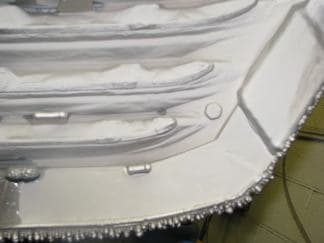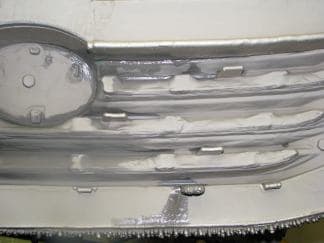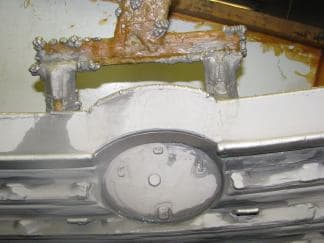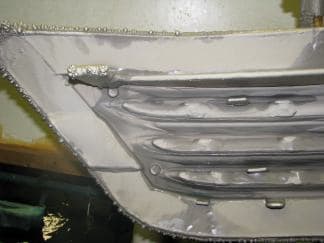
Curated with aloha by
Ted Mooney, P.E. RET

The authoritative public forum
for Metal Finishing 1989-2025

-----
Blistering in Nickel Sulfamate Electroforming
Q. I am currently using a nickel sulfamate tank for electroform plating. I just had a thorough analysis done by MacDermid labs and came back fine on all counts. However, the problem I am having has been ongoing for several years now. I use a silver conductive paint to provide conductivity to plastic and wax forms. I have used this for the last 20 years or so. Until the last several years I have had good success. Now I am finding I am blistering on all projects. Some more than others. When I start the plating at very low voltage and therefore low amperage the blistering is less, but not completely gone. I have tried changing cleaning preparations to no avail. I am wondering if dirty anode bags can be the cause of this by increase pull on cathode? Any ideas would be greatly appreciated.
Michael MurrayPlating shop owner - Toledo, Ohio, USA
January 9, 2010
January 12, 2010
A. Michael,
very likely that you have high compressive stress. Try dummy plating at high current density to remove excess stress reducer

Pat Mentone
St Paul, Minnesota
A. Michael, if you have changed the cleaners to no avail and McDermid confirms the bath is in spec, the only other things it could be are contamination of the nickel bath - try a Hull Cell and see how the nickel comes out on that; I assume you are using the same silver paint that you have been for 20 odd years, so it may be the paint has gone off and is contaminated with something, so try getting a sample of new paint and seeing if it still blisters. If neither of these solve the problem, what other things have changed in your process?.

Trevor Crichton
R&D practical scientist
Chesham, Bucks, UK
January 14, 2010
Q. What can cause compressive stress? I haven't done a hull cell analysis yet, but when I plate just on steel/stainless steel without paint it seems to be ok.
Mike Murray [returning]- Toledo, Ohio, USA
January 26, 2010
Q. A while ago we used an sulfuric acid reverse plating process. It is possible that drag out may have entered the nickel tank. Can this be removed by high amp dummy plating process?
Michael Murray [returning]- Toledo, Ohio, USA
January 27, 2010
January 28, 2010
A. Michael
Compressive stress is usually caused by having too much of a sulfur containing additive in the bath. Usually these additives are ionic and not completely removed by carbon treatment. High current density dummying removes them rapidly since more sulfur plates out at high CD than at low CD.
Another way is to add NaCl or KCl. this will reduce the compressive stress and eventually cause tensile stress.
The dragin from an anodic sulfuric etch most likely contains sulfuric acid and metal ions. Most metal ions and sulphate ions increase the tensile stress and our not removed by high CD dummy plating.

Pat Mentone
St Paul, Minnesota
|
|
Q. Pat, - Toledo, Ohio, USA January 29, 2010 A. I recommend to do first a copper acid coat 5-10 microns Bnei Berak, Israel January 30, 2010 |
|
|
A. Do a Hull Cell test and look for contamination - it is a simple test to do and tells you one hell of a lot about the state of your bath  Trevor Crichton R&D practical scientist Chesham, Bucks, UK February 2, 2010 February 2, 2010 A. Mike  Pat Mentone St Paul, Minnesota |
Q. I put a job in this morning at 44 asf. Job was about 6 sq feet. After 15 minute check, it looked great. After another 15 minute check it blistered all over the place. Help.
Mike Murray [returning]- Toledo, Ohio
February 4, 2010
|
|
February 9, 2010 A. Mike,  Trevor Crichton R&D practical scientist Chesham, Bucks, UK Q. I haven't carbon-treated my tank since 2003, nor carbon filtered it. Also, I haven't run and LCD Dummy more than a few hours since that time. Would excessive metal and organic contamination cause this kind of blistering. Also getting cracking. Any comments would be greatly appreciated. Thanks! - Toledo, Ohio, USA February 9, 2010 |
My LCD dummy plate is covered with a dark shiny plate at about 3 asf. My last analysis showed no copper or iron contamination, what about silver contamination from the paint?
Mike Murray [returning]- Toledo, Ohio
March 1, 2010
March 3, 2010
A. Mike ,
Is your ripple O.K .

Khair Shishani
aircraft maintenance - Al Ain, UAE
Q, A, or Comment on THIS thread -or- Start a NEW Thread




